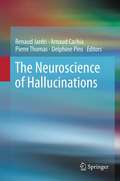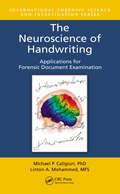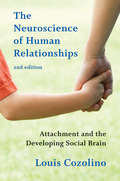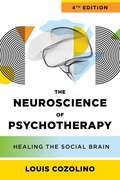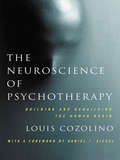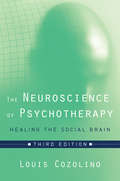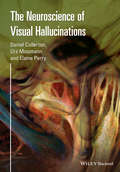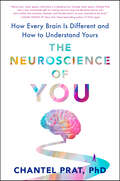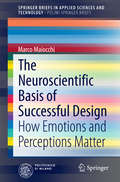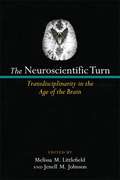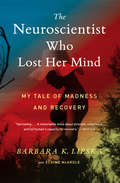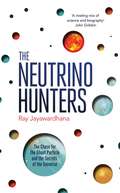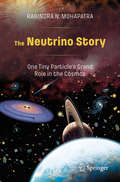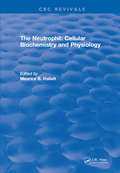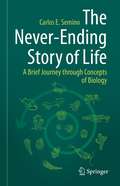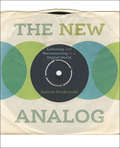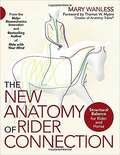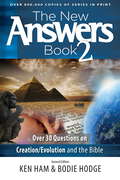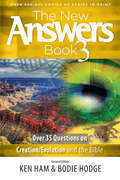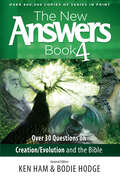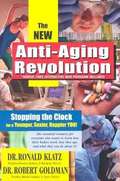- Table View
- List View
The Neuroscience of Freedom and Creativity
by Joaquín M. FusterProfessor Joaquín M. Fuster is an eminent cognitive neuroscientist whose research over the last five decades has made fundamental contributions to our understanding of the neural structures underlying cognition and behaviour. This book provides his view on the eternal question of whether we have free will. Based on his seminal work on the functions of the prefrontal cortex in decision-making, planning, creativity, working memory, and language, Professor Fuster argues that the liberty or freedom to choose between alternatives is a function of the cerebral cortex, under prefrontal control, in its reciprocal interaction with the environment. Freedom is therefore inseparable from that circular relationship. 'The Neuroscience of Freedom and Creativity' is a fascinating inquiry into the cerebral foundation of our ability to choose between alternative actions and to freely lead creative plans to their goal.
The Neuroscience of Hallucinations
by Delphine Pins Pierre Thomas Renaud Jardri Arnaud CachiaHallucinatory phenomena have held the fascination of science since the dawn of medicine, and the popular imagination from the beginning of recorded history. Their study has become a critical aspect of our knowledge of the brain, making significant strides in recent years with advances in neuroimaging, and has established common ground among what normally are regarded as disparate fields. The Neuroscience of Hallucinations synthesizes the most up-to-date findings on these intriguing auditory, visual, olfactory, gustatory, and somatosensory experiences, from their molecular origins to their cognitive expression. In recognition of the wide audience for this information among the neuroscientific, medical, and psychology communities, its editors bring a mature evidence base to highly subjective experience. This knowledge is presented in comprehensive detail as leading researchers across the disciplines ground readers in the basics, offer current cognitive, neurobiological, and computational models of hallucinations, analyze the latest neuroimaging technologies, and discuss emerging interventions, including neuromodulation therapies, new antipsychotic drugs, and integrative programs. Among the topics covered: Hallucinations in the healthy individual. A pathophysiology of transdiagnostic hallucinations including computational and connectivity modeling. Molecular mechanisms of hallucinogenic drugs. Structural and functional variations in the hallucinatory brain in schizophrenia. The neurodevelopment of hallucinations. Innovations in brain stimulation techniques and imaging-guided therapy. Psychiatrists, neurologists, neuropsychologists, cognitive neuroscientists, clinical psychologists, and pharmacologists will welcome The Neuroscience of Hallucinations as a vital guide to the current state and promising future of their shared field.
The Neuroscience of Handwriting: Applications for Forensic Document Examination (International Forensic Science And Investigation Ser.)
by Michael P. Caligiuri Linton A. MohammedThe Daubert trilogy of U.S. Supreme Court cases has established that scientific expert testimony must be based on science grounded in empirical research. As such, greater scrutiny is being placed on questioned document examination generally, and handwriting comparison in particular. Bridging the gap between theory and practice, The Neuroscience of
The Neuroscience of Human Relationships: Attachment and the Developing Social Brain (Second Edition) (Norton Series on Interpersonal Neurobiology) (Norton Series on Interpersonal Neurobiology #0)
by Louis CozolinoA revised edition of the best-selling text on how relationships build our brains. As human beings, we cherish our individuality yet we know that we live in constant relationship to others, and that other people play a significant part in regulating our emotional and social behavior. Although this interdependence is a reality of our existence, we are just beginning to understand that we have evolved as social creatures with interwoven brains and biologies. The human brain itself is a social organ and to truly understand being human, we must understand not only how we as whole people exist with others, but how our brains, themselves, exist in relationship to other brains. The first edition of this book tackled these important questions of interpersonal neurobiology--that the brain is a social organ built through experience--using poignant case examples from the author's years of clinical experience. Brain drawings and elegant explanations of social neuroscience wove together emerging findings from the research literature to bring neuroscience to the stories of our lives. Since the publication of the first edition in 2006, the field of social neuroscience has grown at a mind-numbing pace. Technical advances now provide more windows into our inner neural universe and terms like attachment, empathy, compassion, and mindfulness have begun to appear in the scientific literature. Overall, there has been a deepening appreciation for the essential interdependence of brain and mind. More and more parents, teachers, and therapists are asking how brains develop, grow, connect, learn, and heal. The new edition of this book organizes this cutting-edge, abundant research and presents its compelling insights, reflecting a host of significant developments in social neuroscience. Our understanding of mirror neurons and their significance to human relationships has continued to expand and deepen and is discussed here. Additionally, this edition reflects the gradual shift in focus from individual brain structures to functional neural systems--an important and necessary step forward. A great deal of neural overlap has been discovered in brain activation when we are thinking about others and ourselves. This raises many questions including how we come to know others and whether the notion of an "individual self" is anything more than an evolutionary strategy to support our interconnection. In short, we are just beginning to see the larger implications of all neurological processes--how the architecture of the brain can help us to better understand individuals and our relationships. This book gives readers a deeper appreciation of how and why relationships have the power to reshape our brains throughout our life.
The Neuroscience of Psychotherapy: Healing the Social Brain (IPNB #0)
by Louis CozolinoA new edition of the classic text that links neuroscience and human behavior in a therapeutic context. This groundbreaking book explores the revolution in psychotherapy that brought an understanding of the social nature of people’s brains into a therapeutic context. Louis Cozolino is a master at synthesizing neuroscience and demonstrating how it applies to psychotherapy practice. Here, he argues that all forms of psychotherapy are successful to the extent to which they enhance change in relevant neural circuits. Beginning with an overview of the intersecting fields of neuroscience and psychotherapy, this book delves into the brain’s inner workings, from basic neuronal building blocks to complex systems of memory, language, and the organization of experience. In this updated edition, readers will also find new content on the evolutionary foundations of psychotherapy; the necessity of gaining broad perspectives on mind, brain, and culture in clinical training; the importance of interpreting research with the human brain’s biases in mind; the debatable applicability of Eurocentric perceptions of “self”; and more.
The Neuroscience of Psychotherapy: Healing the Social Brain (Second Edition) (Norton Series on Interpersonal Neurobiology)
by Louis CozolinoHow the brain's architecture is related to the problems, passions, and aspirations of human beings. In contrast to this view, recent theoretical advances in brain imaging have revealed that the brain is an organ continually built and re-built by one's experience. We are now beginning to learn that many forms of psychotherapy, developed in the absence of any scientific understanding of the brain, are supported by neuroscientific findings. In fact, it could be argued that to be an effective psychotherapist these days it is essential to have some basic understanding of neuroscience. Louis Cozolino's The Neuroscience of Psychotherapy, Second Edition is the perfect place to start. In a beautifully written and accessible synthesis, Cozolino illustrates how the brain's architecture is related to the problems, passions, and aspirations of human beings. As the book so elegantly argues, all forms of psychotherapy--from psychoanalysis to behavioral interventions--are successful to the extent to which they enhance change in relevant neural circuits. Beginning with an overview of the intersecting fields of neuroscience and psychotherapy, this book delves into the brain's inner workings, from basic neuronal building blocks to complex systems of memory, language, and the organization of experience. It continues by explaining the development and organization of the healthy brain and the unhealthy brain. Common problems such as anxiety, trauma, and codependency are discussed from a scientific and clinical perspective. Throughout the book, the science behind the brain's working is applied to day-to-day experience and clinical practice. Written for psychotherapists and others interested in the relationship between brain and behavior, this book encourages us to consider the brain when attempting to understand human development, mental illness, and psychological health. Fully and thoroughly updated with the many neuroscientific developments that have happened in the eight years since the publication of the first edition, this revision to the bestselling book belongs on the shelf of all practitioners.
The Neuroscience of Psychotherapy: Healing the Social Brain (Third Edition)
by Louis CozolinoAn update to the classic text that links neuroscience and human behavior in the context of therapy. This groundbreaking book explores the recent revolution in psychotherapy that has brought an understanding of the social nature of people’s brains to a therapeutic context. Louis Cozolino is a master at synthesizing neuroscientific information and demonstrating how it applies to psychotherapy practice. New material on altruism, executive function, trauma, and change round out this essential book.
The Neuroscience of Religious Experience
by Patrick McnamaraRecent technical advances in the life and medical sciences have revolutionized our understanding of the brain, while the emerging disciplines of social, cognitive, and affective neuroscience continue to reveal the connections of the higher cognitive functions and emotional states associated with religious experience to underlying brain states. At the same time, a host of developing theories in psychology and anthropology posit evolutionary explanations for the ubiquity and persistence of religious beliefs and the reports of religious experiences across human cultures, while gesturing toward physical bases for these behaviors. What is missing from this literature is a strong voice speaking to these behavioral and social scientists - as well as to the intellectually curious in the religious studies community - from the perspective of a brain scientist.
The Neuroscience of Visual Hallucinations
by Daniel CollertonEach year, some two million people in the United Kingdom experience visual hallucinations. Infrequent, fleeting visual hallucinations, often around sleep, are a usual feature of life. In contrast, consistent, frequent, persistent hallucinations during waking are strongly associated with clinical disorders; in particular delirium, eye disease, psychosis, and dementia. Research interest in these disorders has driven a rapid expansion in investigatory techniques, new evidence, and explanatory models. In parallel, a move to generative models of normal visual function has resolved the theoretical tension between veridical and hallucinatory perceptions. From initial fragmented areas of investigation, the field has become increasingly coherent over the last decade. Controversies and gaps remain, but for the first time the shapes of possible unifying models are becoming clear, along with the techniques for testing these.This book provides a comprehensive survey of the neuroscience of visual hallucinations and the clinical techniques for testing these. It brings together the very latest evidence from cognitive neuropsychology, neuroimaging, neuropathology, and neuropharmacology, placing this within current models of visual perception Leading researchers from a range of clinical and basic science areas describe visual hallucinations in their historical and scientific context, combining introductory information with up-to-date discoveries. They discuss results from the main investigatory techniques applied in a range of clinical disorders. The final section outlines future research directions investigating the potential for new understandings of veridical and hallucinatory perceptions, and for treatments of problematic hallucinations.Fully comprehensive, this is an essential reference for clinicians in the fields of the psychology and psychiatry of hallucinations, as well as for researchers in departments, research institutes and libraries. It has strong foundations in neuroscience, cognitive science, optometry, psychiatry, psychology, clinical medicine, and philosophy. With its lucid explanation and many illustrations, it is a clear resource for educators and advanced undergraduate and graduate students.
The Neuroscience of You: How Every Brain Is Different and How to Understand Yours
by Chantel PratFrom University of Washington professor Chantel Prat comes The Neuroscience of You, a rollicking adventure into the human brain that reveals the surprising truth about neuroscience, shifting our focus from what&’s average to an understanding of how every brain is different, exactly why our quirks are important, and what this means for each of us. With style and wit, Chantel Prat takes us on a tour of the meaningful ways that our brains are dissimilar from one another. Using real-world examples, along with take-them-yourself tests and quizzes, she shows you how to identify the strengths and weakness of your own brain, while learning what might be going on in the brains of those who are unlike you. With sections like &“Focus,&” &“Navigate,&” and &“Connect,&” The Neuroscience of You helps us see how brains that are engineered differently ultimately take diverse paths when it comes time to prioritize information, use what they&’ve learned from experience, relate to other people, and so much more. While other scientists focus on how &“the&” brain works &“on average,&” Prat argues that our obsession with commonalities has slowed our progress toward understanding the very things that make each of us unique and interesting. Her field-leading research, employing cutting-edge technology, reveals the truth: Complicated as it may be, no two brains are alike. And individual differences in brain functioning are as pervasive as they are fundamental to defining what &“normal&” looks like. Adages such as, &“I&’m not wired that way&” intuitively point to the fact that the brains we&’re piloting, educating, and parenting are wonderfully distinct, explaining a whole host of phenomena, from how easily a person might learn a second language in adulthood to whether someone feels curious or threatened when faced with new information. This book invites the reader to understand themselves and others by zooming in so close that we all look gray and squishy.
The Neuroscientific Basis of Successful Design
by Marco MaiocchiThe term "design" today encompasses attributes of artifacts that go beyond their intended functions, imbuing them with new meanings. Those meanings are deeply related to the emotions perceived by the users. This book investigates the findings deriving from the neurosciences that are relevant to design. Drawing upon up-to-date neuroscientific knowledge, the authors define what an emotion is, examine the relationship between perceptions and emotions and discuss the role of metaphoric communication. Particular attention is paid to those elements of perception and metaphoric interpretation that cause the emotions to rise. Consequences for the design process are then considered and a design process is proposed that takes into account emotional impacts as one of the goals. A solid scientific approach to the subject is maintained throughout and understanding is facilitated by the inclusion of a rich collection of successful design artifacts, the emotional aspects of which are analyzed.
The Neuroscientific Turn: Transdisciplinarity in the Age of the Brain
by Johnson Littlefield Melissa M. Jenell M.The Neuroscientific Turn brings together 19 scholars from a variety of fields to reflect on the promises of and challenges facing emergent "neurodisciplines" such as neuroethics, neuroeconomics, and neurohistory. In the aftermath of the Decade of the Brain, neuroscience has become one of the hottest topics of study---not only for scientists but also, increasingly, for scholars from the humanities and social sciences. While the popular press has simultaneously lauded and loathed the coming "neurorevolution," the academy has yet to voice any collective speculations about whether there is any coherence to this neuroscientific turn; what this turn will and should produce; and what implications it has for inter- or transdisciplinary inquiry. Melissa M. Littlefield and Jenell M. Johnson provide an initial framework for this most recent of "turns" by bringing together 14 original essays by scholars from the humanities, social sciences, and neurosciences. The resulting collection will appeal to neuroscientists curious about their colleagues' interest in their work; scholars and students both in established neurodisciplines and in disciplines such as sociology or English wondering about how to apply neuroscience findings to their home disciplines; and to science, technology, and society scholars and students interested in the roles of interdisciplinarity and transdisciplinarity in the construction of knowledge.
The Neuroscientist Who Lost Her Mind: My Tale of Madness and Recovery
by Barbara K. Lipska Elaine McArdleAs a deadly cancer spread inside her brain, leading neuroscientist Barbara Lipska was plunged into madness—only to miraculously survive with her memories intact. In the tradition of My Stroke of Insight and Brain on Fire, this powerful memoir recounts her ordeal and explains its unforgettable lessons about the brain and mind. In January 2015, Barbara Lipska—a leading expert on the neuroscience of mental illness—was diagnosed with melanoma that had spread to her brain. Within months, her frontal lobe, the seat of cognition, began shutting down. She descended into madness, exhibiting dementia- and schizophrenia-like symptoms that terrified her family and coworkers. But miraculously, just as her doctors figured out what was happening, the immunotherapy they had prescribed began to work. Just eight weeks after her nightmare began, Lipska returned to normal. With one difference: she remembered her brush with madness with exquisite clarity. In The Neuroscientist Who Lost Her Mind, Lipska describes her extraordinary ordeal and its lessons about the mind and brain. She explains how mental illness, brain injury, and age can change our behavior, personality, cognition, and memory. She tells what it is like to experience these changes firsthand. And she reveals what parts of us remain, even when so much else is gone.
The Neurotourist: Postcards from the Edge of Brain Science
by Lone FrankDiscover the true heart of humanity: the brain Your brain shapes your world, but you can also shape your brain. From the God helmet to the No Lie MRI, award-winning journalist Lone Frank embarks on an incredible adventure to the frontiers of neuroscience, revealing how today's top scientists are reinventing human nature, morality, happiness, health, and reality itself. Interlacing bizarre experiments, cutting-edge research, and irreverent interviews, The Neurotourist is an unforgettable tour of the mind-bending revolution underway in the new age of the brain. A critically-acclaimed journalist, science writer, and TV presenter, Lone Frank also holds a PhD in neurobiology and has worked as a research scientist in Denmark and the US. Apart from a particularly 'cute' corpus callosum she has an expert's word that her brain is quite unremarkable. "[A] fascinating exploration of the most intriguing brain experiments so far this century." The New Scientist
The Neutrino Hunters: The Chase for the Ghost Particle and the Secrets of the Universe
by Ray JayawardhanaBefore the Higgs boson, there was a maddening search for another particle - the ghostly neutrino. First detected in 1956, its fleeting appearances have teased answers to many mysteries: How did the Big Bang happen? Why is antimatter so rare? What might dark matter be made of? And could faster-than-light travel be possible, overturning Einstein's theory of special relativity? But the quest for the neutrino also encompasses adventure, from Cold War defections and extra dimensions to mile-deep holes in the Antarctic ice and a troubled genius who disappeared without a trace. With The Neutrino Hunters, renowned astrophysicist Ray Jayawardhana delivers a thrilling detective story of revolutionary science.
The Neutrino Story: One Tiny Particle’s Grand Role in the Cosmos
by Rabindra N. MohapatraEvery second of every day, we are exposed to billions of neutrinos emitted by the Sun, and yet they seem to pass straight through us with no apparent effect at all. Tiny and weakly interacting this subatomic particle may be, but this book will show you just how crucial a role it has played in the evolution of the elements in the universe, and eventually, ourselves.We first start with an introduction to the basics of subatomic physics, including brief backgrounds on the discoveries that set the stage for major 20th century advances. The author, a distinguished theoretical physicist who has researched neutrinos for over thirty years, next explains in nontechnical language how and why the neutrino fits into the wider story of elementary particles. Finally, the reader will learn about the latest discoveries in the past half century of neutrino studies. This semi-popular science book will appeal to any physics students or non-specialist physicists who wish to know more about the neutrino and its role in the evolution of our universe.
The Neutrophil: Cellular Biochemistry and Physiology
by Maurice B. HallettA synthesis and collation of the recent material regarding the role of the neutrophil in basic pathological processes is presented in this volume. The mechanisms of chemotaxis, secretion, phagocytosis, intracellular killing, oxygen radical production and arachidonate production are comprehensively reviewed. Stimulus response coupling in the neutrophil, with chapters on intracellular Ca2+, C-Kinase, phospholipid metabolism, microfilaments and membrane electrophysiology are extensively discussed. Each chapter provides a critical review by experts with over 1,000 cited references. Invaluable to graduate students and medical and scientific researchers, this book provides a unique, up-to-date account of cellular biochemistry and physiology of the neutrophil.
The Never-Ending Story of Life: A Brief Journey through Concepts of Biology
by Carlos E. SeminoFor humankind, the most irreducible idea is the concept of life itself. In order to understand that life is essentially an infinite process, transmitted from generation to generation, this book takes the reader on a fascinating journey that unravels one of our greatest mysteries. It begins with the premise that life is a fact—that it is everywhere; that it takes infinite forms; and, most importantly, that it is intrinsically self-perpetuating. Rather than exploring how the first living forms emerged in our universe, the book begins with our first primordial ancestor cell and tells the story of life—how it began, when that first cell diversified into many other cell types and organisms, and how it has continued until the present day. On this journey, the author covers the fundaments of biology such as cell division, diversity, regeneration, repair and death. The rather fictional epilogue even goes one step further and discusses ways how to literally escape the problem of limited recourse and distribution on our planet by looking at life outside the solar system. This book is designed to explain complex ideas in biology simply, but not simplistically, with a special emphasis on plain and accessible language as well as a wealth of hand-drawn illustrations. Thus, it is suitable not only for students seeking for an introduction into biological concepts and terminology, but for everyone with an interest in the fundamentals of life at the crossroad of evolutionary and cell biology.
The New Analog: Listening and Reconnecting in a Digital World
by Damon KrukowskiAn NPR Best Book of the Year: &“A pointedly passionate look at what&’s been lost in the digital era.&” —Los Angeles Times A longtime musician and former member of the indie band Galaxie 500 who has also taught at Harvard, Damon Krukowski has watched cultural life lurch from analog to digital. And as an artist who has weathered that transition, he has challenging, urgent questions for both creators and consumers about what we have thrown away in the process: Are our devices leaving us lost in our own headspace even as they pinpoint our location? Does the long reach of digital communication come at the sacrifice of our ability to gauge social distance? Does streaming media discourage us from listening closely? Are we hearing each other fully in this new environment? Rather than simply rejecting the digital disruption of cultural life, Krukowski uses the sound engineer&’s distinction of signal and noise to reexamine what we have lost as a technological culture, looking carefully at what was valuable in the analog realm so we can hold on to it. Taking a set of experiences from the production and consumption of music that have changed since the analog era—the disorientation of headphones, flattening of the voice, silence of media, loudness of mastering, and manipulation of time—as a basis for a broader exploration of contemporary culture, Krukowski gives us a brilliant meditation and guide to keeping our heads amid the digital flux. Think of it as plugging in without tuning out. &“This is not a book about why vinyl sounds better; it&’s way more interesting than that . . . [It] is full of things I didn&’t know, like why people yell into cellphones . . . Ultimately, it&’s about how we consume sound as a society—which is, increasingly, on an individual basis.&” —NPR &“If you&’re a devoted music fan who&’s dubious about both rosy nostalgia and futuristic utopianism, Damon Krukowski&’s The New Analog is for you.&” —The New York Times Book Review
The New Anatomy Of Rider Connection: Structural Balance For Rider And Horse
by Thomas W. Myers Mary WanlessFor the past 30-plus years, Mary Wanless and her bestselling Ride with Your Mind books and DVDs have helped revolutionize the art and science of riding horses. Now she takes her pioneering techniques—which combine a lifetime’s influences from the fields of psychology, biofeedback, neuro-linguistic programming, the Alexander and Feldenkrais techniques, Tai Chi, massage, dance, anatomy, sports psychology, and educational kinesiology—to a whole new level. In her newest book, Wanless teams up with Anatomy Trains® creator and author Thomas Myers to examine how the “fabric” of our bodies (fascia) can potentially allow us to generate both stability and what so many riders find elusive even after years in the saddle—“feel.” Recent research shows how the body-wide “net” of fascia that both wraps each muscle and connects your skin to your bones can be the source of postural imbalances and the resulting restrictions in your movement. Wanless posits that the difference between “average” and “elite” riders lies in the quality of connection and awareness within this fascial net, and she gives us the means to take practical and meaningful steps toward addressing such issues, resulting in extraordinary change in the way we look and feel on horseback.
The New Answers Book Volume 1: Over 25 Questions on Creation/Evolution and the Bible (New Answers Books #1)
by Ken HamEvolution...intelligent design...creation...or a little of all three? What do you really believe - and why does it matter to your life, your family, and your faith today? Christians live in a culture with more questions than ever - questions that affect one's acceptance of the Bible as authoritative and trustworthy. Now, discover easy-to-understand answers that reach core truths of the Christian faith and apply the biblical worldview to these subjects: Genesis the Days of Creation millions of years evolution dinosaurs carbon dating UFOs death & suffering Noah's Ark and Flood fossils starlight and time ...and much more. Explore these and other topics, answered biblically and logically in this book from the world's largest apologetics ministry, Answers in Genesis. Timely and scientifically solid, The New Answers Book offers concise answers from leading creationist Ken Ham and scientists such as Dr. David Menton, Dr. Georgia Purdom, Dr. Andrew Snelling, Dr. Jason Lisle, and many more.
The New Answers Book Volume 2: Over 30 Questions on Creation/Evolution and the Bible (New Answers Books #2)
by Ken HamWhat happens when you have more "hot" questions on the Bible and creationism than you can answer in one book? You create a second volume! The New Answers Book 2 explores over 30 exciting and faith-affirming topics, including: The fall of Lucifer and the origin of evil When does life begin (and why does it matter)? Is evolution a religion (and why should I care)? Archaeology, Egyptian Chronology, and the great flood Could early biblical figures like Noah really live to over 900 years of age? What was the Star of Bethlehem (and how did the wise men follow it)? The "Evolutionization" of our culture — including intelligent design, gay marriage, Hollywood movies, and more! Explore these and other topics, answered biblically and logically in this book from the world’s largest apologetics ministry, Answers in Genesis. Contributors include Ken Ham, Dr. Andrew Snelling, Dr. Jason Lisle, Dr. Elizabeth Mitchell, Dr. Danny Faulkner, Mike Riddle, and more.
The New Answers Book Volume 3: Over 35 Questions on Creation/Evolution and the Bible (New Answers Books #3)
by Ken HamThe world around us provides irrefutable evidence of our Creator, but when challenged, can you defend your faith? Do you have answers to your own questions or those of your family about faith, evolution, creation, and a biblical worldview? Get the important information you need in this compelling third book from the popular Answers series, and learn more about: Global warming Cloning and stem cells The existence of God Bacteria and viruses Questions for evolutionists Human and chimp DNA The universe - young or old? "Kinds" in Genesis What Noah's Ark looked like...and much more. Learn how to be more effective in defense of scriptural authority and the truth of Genesis as literal history. Join Ken Ham and leading creation scientists like Dr. Jason Lisle, Dr. Andrew Snelling, Dr. Georgia Purdom, Dr. David Menton, Dr. Terry Mortenson, Dr. John Morris, Dr. Steve Austin, Dr. David DeWitt, Dr. Danny Faulkner, Dr. Joe Francis, and others as they provide simple and empowering answers to these and other popular questions of faith in our culture today. Other exciting books available in this best-selling series: The New Answers Book 1, and The New Answers Book 2, with over 50 additional questions and answers.
The New Answers Book Volume 4: Over 30 Questions on Creation/Evolution and the Bible (New Answers Books #4)
by Ken HamWhat about climate change? Is there a connection between dragon legends and dinosaurs? Is evolution the bloodiest religion ever? What about cavemen? What are the 10 best evidences for a young creation? The Answers series has been a powerful tool in equipping believers to share and defend their faith. Now the newest book in this landmark series takes on hot button topics like climate change, ancient man, and many more. Too many people have walked away from their faith because they sought answers for what seemed a contradiction in Christian belief and scientific teaching. For those who desire a deeper walk and a thriving faith in the face of a growing cultural adversity, now find the answers to questions you have or others may use to genetic engineering, this powerful team of apologists is able to inspire you and those you know who may not yet believe.
The New Anti-Aging Revolution
by Ronald Klatz Robert GoldmanThis book details a program to significantly slow the biological aging process by using diet, exercise, hormonal supplements, etc.

